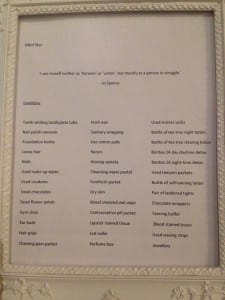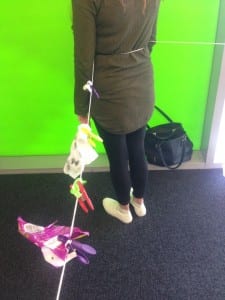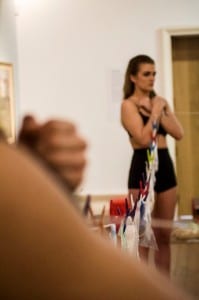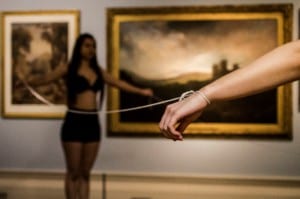Why? Why? Why?
Initially our site specific performance took its main inspiration from the statue of Venus and Cupid by John Gibson held in the Usher Gallery. The statue embodies everything to do with love, beauty and fertility between these two Gods. After studying the story of the great Goddess we realised how she may be perceived as tender, although she was pained with jealously and vanity and is often painted or sculpted to be holding a mirror to illustrate this. Being an all-female group of 4 we decided to play to our strengths, and create a performance which examines women’s struggles to achieve perfection. After visiting the Usher Gallery and its art it became noticeable that many paintings or statues of women were created by men. The gallery was lacking a woman’s voice. This made us more passionate to create a piece that emphasised what we, as women, convince ourselves to do to be seen as beautiful. A lead pioneer in performance art that heavily influenced our work was Marina Abramovic. Abramovic who ‘sometimes refers to herself as “the grandmother of performance art”’ (Brockes, 2014) frequently uses the labour of her body in her art. Works such as; Rhythm 0 (1974), Rhythm 5 (1974) and The Artist is Present (2010) see her place her body under brutal conditions for some duration. The audience present for these performances could see the strain her body was under and could even afflict it on her. We wanted the audience to engage with our piece like Abramovic’s, the labour of the body seemed like a good basis of how we could draw them in. One of our focal points was to present the labour of the body..
Jo Spence, a British photographer, is another woman we took influence from. Spence, like Abramovic,used he r body in her work. Cancer Shock, The Picture of Health and Narratives of Disease were photos taken while Spence was dealing with breast cancer, she documented the entire process. Her photos illustrate the horrific events in which she suffered; Spence didn’t allow her cancer to make her body conscious. Spence questioned why we, as a society, are ‘obsessed with the idealism of youth and beauty’ (Spence, 2015). Our influences facilitated our experimentation with ideas, such as our bodies, society and beauty. We decided that we would use underwear that would enhance our bodies; this meant we would wear control knickers (to hide our stomachs) and a push-up bra. We needed to labour our bodies, so we decided that we would make our piece durational and also wear high heels to elongate our legs to exhibit that beauty is pain. However, we needed to actually show the struggles we face as women, so decided that we would document everything that made us ‘ideal’ women and hang them from our positioned bodies. For example, toe nail clippings, loose hair and used make-up wipes.
r body in her work. Cancer Shock, The Picture of Health and Narratives of Disease were photos taken while Spence was dealing with breast cancer, she documented the entire process. Her photos illustrate the horrific events in which she suffered; Spence didn’t allow her cancer to make her body conscious. Spence questioned why we, as a society, are ‘obsessed with the idealism of youth and beauty’ (Spence, 2015). Our influences facilitated our experimentation with ideas, such as our bodies, society and beauty. We decided that we would use underwear that would enhance our bodies; this meant we would wear control knickers (to hide our stomachs) and a push-up bra. We needed to labour our bodies, so we decided that we would make our piece durational and also wear high heels to elongate our legs to exhibit that beauty is pain. However, we needed to actually show the struggles we face as women, so decided that we would document everything that made us ‘ideal’ women and hang them from our positioned bodies. For example, toe nail clippings, loose hair and used make-up wipes.
Word Count: 479
Preconceived Ideas about Art.
What makes art, art? In more and more art galleries we are experiencing pieces of art that may at first shock or confuse us. In previous years many would only assume art to be paintings or statues, yet that is not the case in today’s society. One piece that we discussed in today’s session was Tracey Emin’s ‘My Bed’ (Emin, 1998). I was not aware of what the piece looked like, my thoughts were what are the differences between her unmade bed and mine? The bed is described ‘as a self-portrait’ (Emin, 1998, cited in Kennedy, 2014) after a long weekend when her relationship broke down. Her bed is actually from her council flat in Waterloo, which is covered in stains, empty bottles and condoms.
After hearing the artist’s explanation of the bed, I realised my preconceived ideas about the piece without seeing the bed were changed. ‘Perspective centres everything on the eye of the beholder’ (tw1975, 2012). This statement is completely true as everyone has they own ideas and opinions about pieces of art; but when we hear other peoples explanations this too can influence our own. I now can appreciate this piece of art as it shows the despair of a heartbroken woman and do not see it as just an unmade bed. Emin’s bed sold for a huge £2.54m (Kennedy, 2014) and has been held a numerous museums including the Tate Modern in London.
We are performing in the Usher Gallery in Lincoln for our performance, the gallery has been open since 1927 (The Collection, 2015). In most site-specific pieces the location and the performance intertwine. The performance often uses the space’s history or purpose to influence the piece in some way, though this is not always the case. ‘Performers and audience experience a sense of ‘touching’ the building, and are aware of how the space…can be…reflected within the performance’ (Govan et al, 2007, 111). The performance may hold ‘traces of [the space’s]…purpose and haunted by the ghosts of those who have used them’ (Govan et al, 2007, 139). The audience may change their perspective they had for that certain space.
Additionally by performing in a non-traditional theatrical performance space the audience may be forced to lose any preconceived ideas they hold. Performing in the Usher gallery means we have to be respectful of their health and safety requirements as well as thinking of our own. By choosing to perform in this location we have to think about what or who is surrounding us. There are certain things that we are not allowed to bring into the gallery because it may damage the art, such as water or pens. Some people may say it may limit our creativity by these constraints, as performers we want to be able to use or do whatever we think will make our piece engaging. So surely performing in a theatre is easier as you get the freedom you want? However, with site specific performances are about allowing the location to influence you, as well as how you can use the ‘constraints’ to work in your favour. Don’t see it as a boundary, but a push into the right direction.
Word Count: 529
Sniff Sniff
For my group’s original site specific performance idea we want to focus on how the manipulation of the senses can influence an individual’s interpretation of a piece of art. One sense our group want to incorporate is smell, and how different types of smell can arise certain ideas or memories. We are exploring the idea of using four completely different smells on four participants; each individual will only experience one of the four smells. This means that each audience member will not have the same experience as one another. Then see how their opinions on the artwork are affected by the use of smell and their own memories. It is about changing the gallery goers’ ideas about how you view and getting them to see it from a different point of view.
Selecting the smells will be challenging as they all come will numerous connotations. Each smell will create different ideas depending on the individual. For example someone could smell flowers and link that with the idea of love, although another people could smell the same flowers and think of lost or sorrow. We plan on running the performance at least four times so we can get a range of interpretations from the participants. We are looking at four different artworks from the Viewpoints in the Collection Museum. Although we will have to be respectful of the health and safety in the Museum as we are not allowed liquids as they could potentially damage the artefacts, so we will have to experiment with how we can bring the smells in the building, without the actual liquids.
A theatre company that have used smell in their productions is the Pigeon Theatre Company in their performance of The Smell of Envy (2013). The theatre company wanted to ‘celebrate and interrogate the workings of the nose and the brain’ (Pigeon Theatre, 2013). Additionally how certain familiar and unfamiliar smells could manipulate the audiences thoughts and memories. They used older actors and their memories to create a ‘smell-scape’, the different smells create a story for the audience. I often forgot how the use of smell can be used to influence an individual, as this sense is not often used in everyday performances. I think our performance is influenced by the Pigeon theatre’s The Smell of Envy as they use different smells which will create a different experience depending on the individual and their memories. ‘The same event is experienced, remembered, characterised in a multitude of different ways’ (Pearson and Shanks, 2001, 57). We want to engage every audience member and make them experience something a little different.
Word Count: 433
Simple Yet Effective
In last week’s session we gave our performance proposals. This was where we were able to see if the museum had any issues with our ideas and if our ideas needing a slight altering. After listening to the other groups’ ideas I could see how they had a simple idea which had direct aims and intentions. Although with my group our feedback did make us think about our initial idea and what we wanted to create. Our feedback was beneficial as I could see that we had over complicated our idea. I believe we were over reaching what we could actually achieve, as we had numerous elements we had to incorporate such as; senses, colours, video documentation and mirrors. After the proposal we were all in agreement that we needed to simplify our idea or change our idea completely, so we would not get confused attempting to pull off more than we could.
One performance artist we could take inspiration from is Marina Abramovic. After watching documentary The Artist is Present (Abramovic, 2012), we saw Abramovic creating a powerful durational performance that saw her sitting opposite an empty chair with a table in between. In addition to her new performance the Museum also reproduced some of her previous work which spanned over 4 decades. The performance was held in the MoMA, Museum of Modern Arts (New York), and lasted over 3 months. Abramovic had to have intense focus and commitment, like all other artists, so she could endure the physical and emotional strain she would face every day. Although the performance would prove challenging to anyone, Abramovic never saw ‘quitting [as]…an option,’ (Abramovic, 2010, cited in Stigh, 2010). Thousands came to see her whether it sitting opposite her in the chair or observing from the side, they were still present in the moment. The performance was ‘about stillness and about literally doing nothing and being in the present,’ (Abramovic, 2010, cited in Stigh, 2010). As there was no conversation between the artist and the person all they had was eye contact and their own thoughts. The silence brought many different emotions to those present, some smiled while others cried. When sitting opposite Abramovic you were isolated from speech, with gallery goers silently watching her, for as long as they wanted. ‘The same event is experienced, remembered, characterised in a multitude of different ways’ (Pearson and Shanks, 2001, 57). Everyone who viewed the performance may feel differently about what they saw, compare to those who only heard about it. Whatever way you experience the performance it creates pause for thought.
This performance illustrates that simple ideas can often be the most powerful; I believe that my group can look into Abramovic’s performance and create a simple and powerful experience for those watching. We just need to focus on what is important and what we want to portray. We realised after our pitch that we were over stretching our idea and needed to think of a new idea. After looking around the Usher Gallery we were all drawn towards the statue of Venus and her idealism. However, just because we like the statue does not mean we have a performance idea, we will have to research her story and how we can make a site specific piece.
Word Count: 545
All Talk…
After weeks of attempting to get a performance together and discussing numerous ideas in-depth we finally realised that we need to do. Within our process we needed to get up and experiment our concept, rather than just thinking of all the pros and cons of each of them. Failing is part of the process, if an idea did not work or seemed weak it was still beneficial to our process. One of our peers drew the analogy of our theatrical ideas and ‘babies’. Like a baby, we spent extensive amounts of time nurturing them and becoming protective. Our peer claimed however, we should be pragmatic and not hesitate when it comes to ‘killing our babies’. After realising we were going around in circles the group decided that now we need to get up and be willing to kill our babies if they were not effective.
The idea we decided that we would develop was to explore the struggles women face to achieve perfection. We explored our ‘washing line’ idea.  We used string to connect us all together and I then pegged objects to the string to represent a washing line. The items would reflect the realistic side of a woman’s beauty such as; used waxing strips, dirty underwear, leg hair and high heels. These are just a few objects that we experimented with. By actually doing something we were able to realise that we did like the concept we were portraying through the ‘washing line’ idea. By putting objects which society may forget or not necessarily associate with beauty, I believe it does represent what women go through to keep up with this idea of being ‘the ideal woman’. Nevertheless, as we are a group made up of women and have heavily focused on the Venus statue which is featured in the Usher Gallery we decided that we would play to our strengths and only show our own objects. We have experimented with our own objects to make it personal and reflect what us four go through to live up to this idea of beauty. Although we are still adapting this idea of using the washing line, we just wanted to get up and do something and then see if it failed, rather than just discussing it-again.
We used string to connect us all together and I then pegged objects to the string to represent a washing line. The items would reflect the realistic side of a woman’s beauty such as; used waxing strips, dirty underwear, leg hair and high heels. These are just a few objects that we experimented with. By actually doing something we were able to realise that we did like the concept we were portraying through the ‘washing line’ idea. By putting objects which society may forget or not necessarily associate with beauty, I believe it does represent what women go through to keep up with this idea of being ‘the ideal woman’. Nevertheless, as we are a group made up of women and have heavily focused on the Venus statue which is featured in the Usher Gallery we decided that we would play to our strengths and only show our own objects. We have experimented with our own objects to make it personal and reflect what us four go through to live up to this idea of beauty. Although we are still adapting this idea of using the washing line, we just wanted to get up and do something and then see if it failed, rather than just discussing it-again.
Word Count: 377

The End is in Site
For our final performance we documented the struggles women face to achieve perfection. With Chloe, Emma and Winona tided together by string to represent a washing line around our initial inspiration, the statue of Venus and Cupid. They positioned their bodies to illustrate that they were slaves to beauty, by crossing their arms. This expression was symbolic as they had to hold this position for an extensive period to display the labour of the body.
Whilst they acted as an integral part of the washing line I went around and hung our collected documentation. The items we composed were implicit to a certain extent, such as the foot shavings and the dead flower petals as the audience may not see their importance. However, I believe this was one of our weaknesses with the objects, if given more time we would have been able to collect more and it possibility would have had a bigger impact on the gallery goers. For instance British artist Joshua Sofaer decided to invite his participants on a scavenger hunt, where they would find and collect the objects in question. The collected objects were displayed together. Sofaer invited the ‘audience [to] become ‘artists’’ (Sofaer, 2009, 63) by the participants collecting the items they created the final piece. So instead of having a few of one item we could have had hundreds or even thousands, this would have engaged the audience may be more as they could see to what extent women are paranoid about their appearance. Additionally we could even invite people to donate their own items such as used make-up wipes and ear buds. This would demonstrate it’s not only us, the four performers, who worry about being the ‘ideal woman’ but a communal struggle. Although this idea offers its own problems, many women would not be comfortable with having their ‘dirty laundry’ hung up.
Our performance attracted the attention of the people in the museum, many stopped and watched us, even young families came in which is something I did not expect. Whilst we rehearsed our idea, many women avoided even looking at our performance when they came in the room. Although when it came to the actual performance and us wearing less clothes we noticed that overall, more men than women came and watched our performance. Was this because of our statement about the struggles of achieving beauty or were they just attracted by the semi- nudity aspect? If given more time I would like to perform a few more times and alter our costume to see the different effects it would have on the audience numbers. My engagement with site specific theory and practice at first was hard to grasp. The idea of performing in a non-traditional venue did prove challenging. However, after viewing other practices I started to realize how far we could push our performance once we finally created our concept. Additionally we developed our idea though always had to be respectful of the space we were performing in.
Word Count: 499


Work Cited
Stigh, D. (2010) Marina Abramovic: The Artist Speaks. [online] Available from: http://www.moma.org/explore/inside_out/2010/06/03/marina-abramovic-the-artist-speaks [Accessed 14 February 2015].
Pigeon Theatre (2013) The Smell of Envy (a show). [online] Available from:
https://pigeontheatre.wordpress.com/thesmellofenvy/ [Accessed 25 Februray 2015].
Pearson, M. and Shanks, M. (2001) Theatre/ Archaeology: Disciplinary Dialogues. London: Routledge.
Govan, E., Nicholson, H. and Normington, K. (2007) Making a Performance, Devising Histories and Contemporary Practices. London: Routledge.
The Collection (2015) Art at The Collection. [online] Available from: http://www.thecollectionmuseum.com/?/visiting-us/art-at-the-collection [Accessed 23 March 2015].
Kennedy, M. (2014) Tracey Emin’s bed returns to the Tate. [online] Guardian. Available from: http://www.theguardian.com/artanddesign/2014/jul/29/tracey-emin-my-bed-tate-loan [Accessed 4 February 2014].
Brockes, E. (2014) Performance artist Marina Abramovic ‘I was ready to die’. Available from: http://www.theguardian.com/artanddesign/2014/may/12/marina-abramovic-ready-to-die-serpentine-gallery-512-hours [Accessed 10 May 2015].
Spence, J (2015) Narratives of Disease. [online]. Available from: http://www.jospence.org/work_index.html [Accessed 10 May 2015].
Sofaer, J. (2009) The Many Headed Monster. London: Live Art Development Agency.
Tw1975 (2012) John Berger / Ways of Seeing, Episode 1 (1972) [online video] Available from: https://www.youtube.com/watch?v=0pDE4VX_9Kk [Accessed 4 February 2014].
Abramovic, M. (2012) The Artist is Present. [DVD] 106 mins. New York: MoMA.
Emin, T. (1998) My Bed. [still life]London: Tate Modern.
All photographs taken by Fenia Kotsopoulou.
Recent Comments